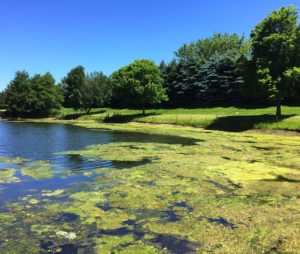Algal Blooms: What Are They and How to Prevent Them

Algal blooms can be a significant concern for property owners who have ponds, lakes, or water features in their landscapes. These rapid algae growths can turn your water green, produce unpleasant odors, and harm aquatic life. At Scientific Plant Service, we want to help you understand what algal blooms are and how to effectively prevent them.
What Are Algal Blooms?
Algal blooms occur when algae in the water multiply rapidly, often in response to favorable environmental conditions. These blooms can range in color from green to red, brown, or blue-green, depending on the type of algae. While algae are a natural part of aquatic ecosystems, excessive growth creates problems.
- Harmful Algal Blooms (HABs): Some algal blooms produce toxins harmful to humans, pets, and wildlife. These are known as harmful algal blooms (HABs) and can pose significant health risks.
- Eutrophication: Algal blooms are often a result of eutrophication, which is the enrichment of water bodies with nutrients like nitrogen and phosphorus. These nutrients can originate from various sources, such as agricultural runoff, improperly applied lawn fertilizers, and septic systems.
Causes of Algal Blooms
Several factors contribute to the formation of algal blooms, including:
- Nutrient Overload: Excess nutrients, particularly nitrogen and phosphorus, are the primary drivers of algal blooms. These nutrients can enter water bodies through stormwater runoff, agricultural runoff, and improper fertilizer use.
- Warm Temperatures: Algae thrive in warm conditions, so higher temperatures can accelerate their growth. This is why algal blooms are more common during the summer months.
- Stagnant Water: Still or slow-moving water provides an ideal environment for algae to flourish. Lack of water circulation can exacerbate bloom conditions.
- Sunlight: Algae require sunlight to photosynthesize. Clear, shallow water bodies with ample sunlight are more susceptible to algal blooms.
How to Prevent Algal Blooms
Preventing algal blooms involves managing nutrient inputs and improving water quality. Here are a few practical strategies:
Reduce Nutrient Inputs
- Use Fertilizers Wisely: Apply fertilizers sparingly and at recommended rates. Opt for slow-release fertilizers that minimize nutrient runoff.
- Buffer Zones: Establish buffer zones of native vegetation around water bodies to filter runoff and absorb excess nutrients before they reach the water.
Improve Water Circulation
- Aeration: Install aerators or fountains to enhance water circulation and oxygenation. This helps prevent stagnation, which promotes algal growth.
- Water Movement: Use pumps or water features to keep the water moving. Increased water flow disrupts algae growth and distribution.
Limit Sunlight Exposure
- Utilize a dye that contains a blend of blue and yellow dyes designed to absorb specific wavelengths of light critical to plant photosynthesis.
- Shading Structures: Consider using shade cloths or planting trees around the water body to limit direct sunlight.
Regular Maintenance
- Remove Debris: Regularly remove organic debris such as leaves, grass clippings, and dead plants from the water. Decomposing organic matter can release nutrients that fuel algal growth.
- Monitor Water Quality: Test the water regularly for nutrient levels and other indicators of water quality. Early detection of nutrient spikes can help you take preventative measures.
You can maintain a healthy and clear pond by understanding the causes of algal blooms and implementing these preventative strategies. At Scientific Plant Service, we are dedicated to helping you create and sustain beautiful outdoor environments. For more information or professional assistance, please contact us.
Scientific Plant Service Is Your Go-To Source In Landscape Healthcare
Scientific Plant Service, located in Baltimore, is a privately owned corporation, chartered in Maryland in 1957 by Frank J. Burke. We started as a full-service Arborists specializing in the care of shade trees and ornamental shrubs, but today we are a Lawn Care company that is a huge part of the community. From aquatic environments and snow management to deer and mole control, SPS has services tailored specifically for your lawn and landscape.
We offer services in Maryland, Washington, DC, and Virginia, including: Harford, Baltimore, Carroll, Frederick, Howard, Anne Arundel, Montgomery, Prince Georges, Talbot, Queen Anne’s, Calvert counties in MD, as well as Loudoun County, Fairfax County, Arlington, Alexandria, and Falls Church in VA. For more information, contact us online, or call us at 410-321-0970. Be sure to follow us on Facebook, Twitter, LinkedIn, Instagram, and Pinterest.
